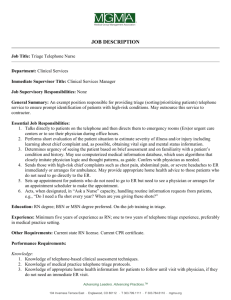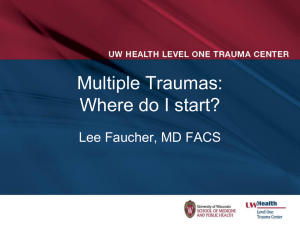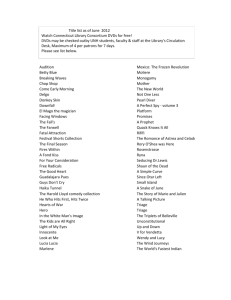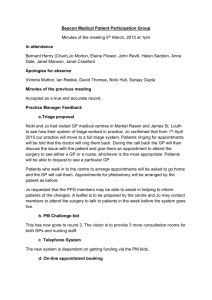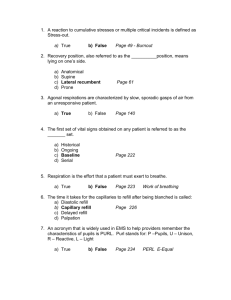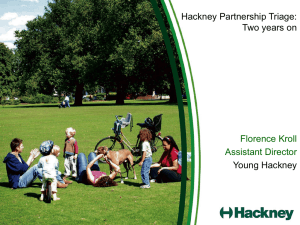5) Casualty Triage
advertisement
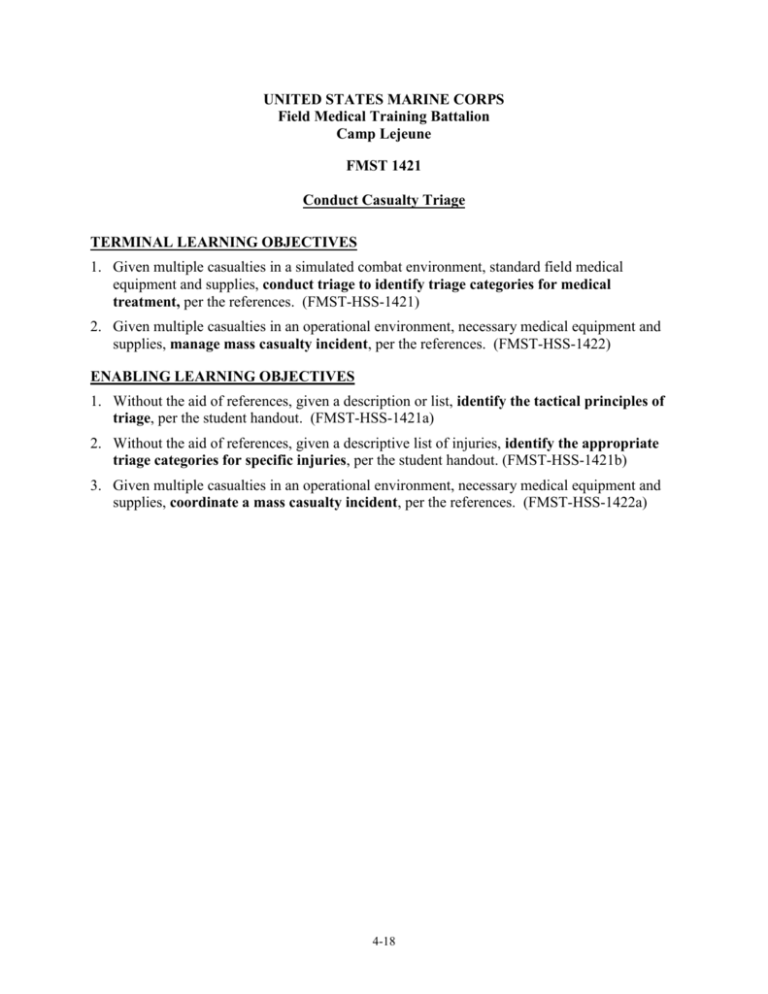
UNITED STATES MARINE CORPS Field Medical Training Battalion Camp Lejeune FMST 1421 Conduct Casualty Triage TERMINAL LEARNING OBJECTIVES 1. Given multiple casualties in a simulated combat environment, standard field medical equipment and supplies, conduct triage to identify triage categories for medical treatment, per the references. (FMST-HSS-1421) 2. Given multiple casualties in an operational environment, necessary medical equipment and supplies, manage mass casualty incident, per the references. (FMST-HSS-1422) ENABLING LEARNING OBJECTIVES 1. Without the aid of references, given a description or list, identify the tactical principles of triage, per the student handout. (FMST-HSS-1421a) 2. Without the aid of references, given a descriptive list of injuries, identify the appropriate triage categories for specific injuries, per the student handout. (FMST-HSS-1421b) 3. Given multiple casualties in an operational environment, necessary medical equipment and supplies, coordinate a mass casualty incident, per the references. (FMST-HSS-1422a) 4-18 1. TACTICAL TRIAGE Triage is a French word meaning “to sort”. Casualties are sorted into groups based on their immediate medical needs. Using a standardized approach to triage casualties helps combat medics correctly segregate, treat, and prioritize evacuation in the shortest time possible. The realities of combat dictate that battlefield triage must take place in an environment limited in resources for treatment and transport. Triaging casualties merely establishes order of treatment and movement (see box 1). Although all casualties require treatment, triage aids the Corpsman in deciding which casualties have the greatest probability of survival and Triage ensures the greatest care for helps weigh the casualties need for lifesaving the greatest number of casualties and the interventions (LSIs), thus determining maximum utilization of medical priority and urgency for treatment and personnel, equipment, and facilities, especially in a mass casualty incident evacuation. (MCI). Triage establishes the patients’ category. -PHTLS 6th Edition p. 548 Although the type and extent of the wound may offer clues as to the triage category a patient may fall into, it is their physiological state (how well there body is working) that is the critical factor. For instance, a patient with a weak radial pulse indicates an estimated systolic blood pressure of 80 mm/Hg. Studies of combat related injuries indicate that 32% of these individuals will die. The absence of a radial pulse indicates a systolic blood pressure of less than 50 mm/Hg. The same study reported that 92% of these individuals will die. On the other hand, a separate trauma study indicated that no casualty died if they presented during the first stages of triage with a palpable radial pulse and the ability to follow simple commands. 2. PRINCIPLES OF TACTICAL TRIAGE - Accomplish the greatest good for the greatest number of casualties - Employ the most efficient use of available resources - Return personnel to duty as soon as possible 3. THE FOUR CATEGORIES OF TACTICAL TRIAGE Categories are color coded and are recognized as follows: MINIMAL (GREEN TAG) Also known as the “walking wounded.” Although these patients may appear to be in bad shape at first, remember, it is their physiological state that tells the true story. Examples include but are not limited to – small burns, lacerations, abrasions, and small fractures. These casualties have minor injuries and can usually care for themselves with self-aid or “buddy aid”. These casualties should still be employed for mission requirements (e.g., scene security). 4-19 DELAYED (YELLOW TAG) The delayed category includes wounded casualties who may need surgery, but whose general condition permits a delay in surgical treatment without unduly endangering life or limb. Medical treatment (splinting, pain control, etc.) will be required but it can wait. Examples include but are not limited to – casualties with no evidence of shock who have large soft tissue wounds, fractures of major bones, intra-abdominal or thoracic wounds, or burns to less than 20% of total body surface area. Box 1: Triage in Tactical Combat Casualty Care (TCCC) Care Under Fire Phase CASEVAC Phase 1. Move casualties who are not clearly dead to cover, if possible. 1. Triage casualties again. Categories and treatment requirements can and will change. 2. Treat any life-threatening hemorrhage. 2. Use any advanced diagnostic equipment available at this level to assist in triage. 3. Continue with the mission or fight. Tactical Field Care Phase 1. Perform an initial rapid assessment of the casualty for triage purposes. This should take no more than 1 minute per patient. 3. Soft tissue injuries are common and may look serious, but these injuries do not kill unless associated with shock. 2. If a casualty can walk, he or she will probably be all right. 4. Bleeding from most extremity wounds should be controllable with a tourniquet or hemostatic dressing. CASEVAC delays should not increase mortality if bleeding is fully controlled. 3. Perform immediate lifesaving interventions (LSIs) as indicated. Move rapidly. 5. Casualties who are in shock should be evacuated as soon as possible. 4. Reverse treatment from ABC to CBA (circulation, breathing, and airway). The majority of casualties will have injuries requiring hemorrhage control. It does no good to ensure a good airway when the casualty has lost too much blood to survive. 6. Casualties with penetrating wounds of the chest who have respiratory distress unrelieved by needle decompression of the chest should be evacuated as soon as possible. 7. Casualties with blunt or penetrating trauma of the face associated with difficulty breathing should immediately receive definitive airway control and be evacuated as soon as possible. 5. Talk to the casualty while checking the radial pulse. If the casualty obeys commands and has a normal radial pulse, he or she has a greater than 95% chance of living. 6. If the casualty obeys commands but has a weak or absent radial pulse, he or she is at increased risk of dying and may benefit from an immediate LSI. This casualty is in the immediate category. 7. If the casualty does not obey commands and has a weak or absent radial pulse, he or she has a greatly increased chance of dying (>92%) and may benefit from an immediate LSI. 8. Prepare casualties to move out of the area. 9. Prevent hypothermia. 8. Casualties with blunt or penetrating wounds of the head associated with obvious massive brain damage and unconsciousness are unlikely to survive with or without emergent evacuation. Therefore, they would be in the expectant category. 9. Casualties with blunt or penetrating wounds to the head in which the skull has been penetrated but the casualty is conscious should be evacuated emergently. 10. Casualties with penetrating wounds of the chest or abdomen who are in shock at their 15 minute evaluation have a moderate risk of developing late shock from slowly bleeding internal injuries. They should be carefully monitored and evacuated as soon as feasible. 4-20 IMMEDIATE (RED TAG) The immediate category includes casualties who require immediate LSI and/or surgery. Put simply, if medical attention is not provided, the patient will die. The key to successful triage is to locate these individuals as quickly as possible. Casualties do not remain in this category for an extended period of time, they are either found, triaged and treated, or they will die! Examples include but are not limited to – hemodynamically unstable casualties with airway obstruction, chest or abdominal injuries, massive external bleeding, or shock. EXPECTANT (BLACK TAG) Casualties in this category have wounds that are so extensive that even if they were the sole casualty and had the benefit of optimal medical resources, their survival would be highly unlikely. Even so, expectant casualties should not be neglected. They should receive comfort measures, pain medications, if possible, and they deserve re-triage as appropriate. Examples include but are not limited to – casualties with penetrating or blunt head wounds and those with absent radial pulses. 4. Because the tactical environment precludes an extensive array of monitoring equipment, optimal battlefield treatment and evacuation rely on simple triage tools. Based on research by the Committee on Tactical Combat Casualty Care, a triage decision algorithm has been developed (see figure 1). Using this method will enable the FMST to perform an initial triage of many individuals in a quick and systematic manner. - Patients who can ambulate and follow instructions usually will fall into the minimal category. Statements such as “If you can hear my voice get up and move behind the building” (or any other place tactically correct) can triage a large portion of the casualties in a short time. - Patients with obvious signs of death can be initially placed in the expectant category. - Casualties who do not fit either of the above categories will need further evaluation. - Massive bleeding is the most obvious sign of the need for a LSI. It may need a tourniquet, a hemostatic agent, or a pressure bandage. - Once the LSI has been performed the patient is immediately re-triaged. - According to the algorithm, patients are placed in the delayed category if they can obey simple commands, possess a normal radial pulse, and are not in respiratory distress. 4-21 Care Under Fire Phase Drag the casualty to cover, stop any life-threatening hemorrhage, continue with mission/fight Tactical Field Care / CASEVAC Phase Scene security and establish a Casualty Collection Point (CCP) Minimal Category Walking wounded Perform cursory evaluation Obvious signs of death Expectant Casualty Further evaluation required Obvious LSI required? Yes No Casualty obeys commands? No Immediate Casualty Yes Radial pulse character Abnormal Normal Casualty in respiratory distress? Yes Delayed Casualty Figure 1. Triage Algorithm for Tactical Combat Casualty Care 4-22 5. MASS-CASUALTY TRIAGE Corpsmen operating in a tactical environment must always be prepared to deal with a mass casualty incident. Units must establish and rehearse plans for dealing with such a situation. In a mass casualty situation those responsible for triage must remember that triage is not treatment and constant reassessment is needed to identify casualties who may have deteriorated or improved. 6. TRIAGE TAGS Triage tags are designed to communicate the triage category, treatment rendered, and other medical information. By necessity, the information on the tag is brief. Triage tags are usually placed on the casualty by the triage officer although other members of the team may place or add information to the tags. NATO Card (METTAG: Medical Emergency Triage Tag) (see figure 2) Purpose - To furnish the attending care provider during the evacuation of a casualty with essential information about the injury or disease and the treatment provided. - The sole or initial medical record for the troops injured in combat. - Each triage tag is coded with a unique sequential seven-character serial number used for identification and tracking of the casualty. The serial number is located on the top right and left diagonal tear-offs. Routing - The card stays with the patient at all times. - The yellow corner with the ambulance picture and a serial number stays with the evacuating vehicle. - The yellow corner with the first aid sign and serial number stays at the BAS. 4-23 NATO CARD (METTAG) (FRONT) NATO CARD (METTAG) (BACK) Figure 2. NATO Card (METTAG) REFERENCES Tactical Emergency Care, Pgs. 230-245 Pre-Hospital Trauma Life Support; Military Edition, 6th Ed, Chapter 23 REV: July 2008 4-24 Triage Review 1. Describe the general condition of a patient in the “delayed category”. 2. What is the key to successful triage? 3. List two important things for the triage Corpsman to remember when dealing with a mass casualty scenario. 4. Using the triage algorithm, a patient that can obey simple commands, has a normal radial pulse, and is not in respiratory distress would be placed in which category? 4-25


